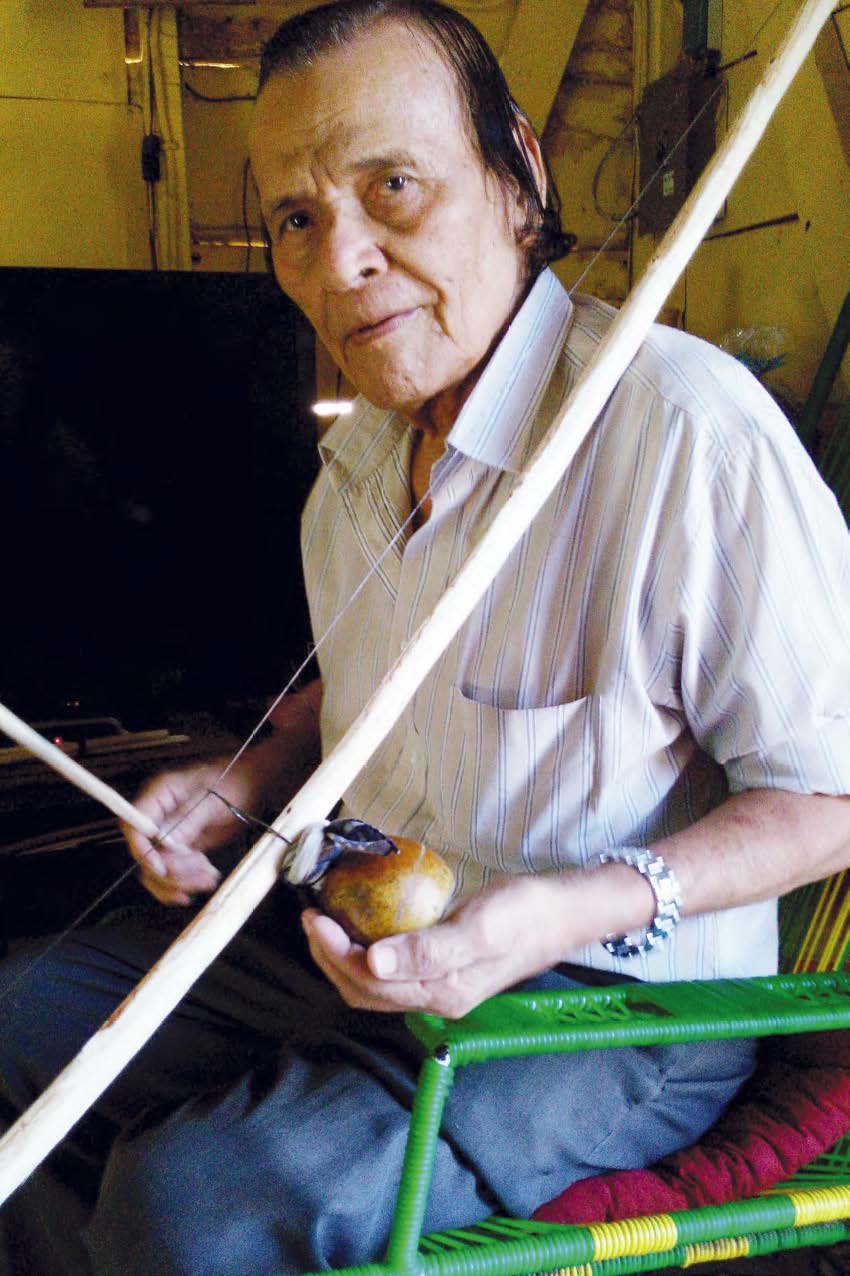
ISIDORO GUADAMUZ – Master of traditional quijongo instrument
Isidoro Guadamuz de la O is one of the two last guardians of a knowledge that will probably die with them: how to build and play an exotic Guanacastecan musical instrument called the quijongo. It looks like a large bow, as in bow and arrow, with a round gourd, or calabash, called a jícaro attached to the middle.
The string of the bow is made of wire from pickup truck tires, and it’s struck with a stick at different places to produce higher or lower notes. The other hand is used to cover and uncover the hollow gourd, creating an effect that seems to bend and stretch the notes, making a “wa-oo, wa-oo” sound. Guadamuz, 83, is a native of Santa Cruz of indigenous heritage and a lifelong musician and music teacher. In 2014, he was honored with the Popular Cultural Tradition Prize for his contributions to keeping Guanacastecan music alive. He sat down with the Howler at his home in Santa Cruz to tell us his story, introduce us to the quijongo and show us how to play it.
An anthropologist named Adriana Mendez, who has written a short biography of Guadamuz and has researched the story of the quijongo, said in a telephone interview that it originated in Africa and came to the Americas with slaves brought by the Spanish centuries ago. SPOTLIGHT Master of traditional quijongo instrument is one of a dying breed
You start with a tree branch over 2 meters long, and you skin it and bend it into the shape of a bow. But Guadamuz staunchly disputes this, saying it originated with the Chorotega indigenous group right here in Guanacaste.
“Look, were the Africans as cultured as people in America?” he asked. “The Chorotega were the ones who developed the quijongo, they were the ones who used bows and arrows, because the Africans used spears, or sharp axes. … And it wasn’t in Peru, Colombia or Mexico, it was from here, the Chorotega, where the bow and arrow were developed.”
Guadamuz says he remembers being 5 years old and walking for five hours with his father from Santa Cruz to Nicoya to watch musicians play marimbas and quijongos. When he was in the 4th or 5th grade, a man from Matapalo came to his school in Santa Cruz to introduce the children to this instrument.
“And I said, ‘Sir, why don’t you explain to me how you make this instrument?’” Guadamuz recalled. “And he said, ‘Ay, muchacho, out of 300 or 500 students I’ve had, you’re the only one who’s asked me that, so how am I not going to tell you?’”
You start with a tree branch over 2 meters long (Guadamuz finally discovered that a guácimo branch works best), and you skin it and bend it into the shape of a bow. You add the cord — which was initially made from vines, but Guadamuz discovered that tire wire made a much better sound.
“The cord I use now is wire from pickup truck tires,” he said. “Not just any wire will work. It has to be a No. 15. No. 14 is not going to sound right, or No. 16 either.”
You have to search for the perfect gourd from the jícaro, or calabash tree, and clean it out and attach it to the middle, with a handkerchief tied around its base. Then you whittle a stick to hit the cord with. Finally, there’s a hollow resonance box, now made of plywood, on which the base of the instrument rests to amplify the sound.
Some quijongos also have toe grips to hold the base of the bow steady against the resonance box with one bare foot. By the age of 13, Guadamuz was building his own quijongos, but he said they sounded terrible: “Pling, pling, pling.” But he persisted, and by the time he was 15, he had finally built one that sounded right.
He would continue to innovate and perfect the design for much of his life. Meanwhile, he was an active member of the Municipal Band of Santa Cruz, playing baritone, trumpet, tenor sax, trombone and bass. He also built and played his own marimbas. After he graduated from school, he became a music teacher.
In his long career, he has played at Costa Rica’s National Theater, the Melico Salazar Theater, the Legislative Assembly and the Casa Presidencial, as well as in Nicaragua and Colombia. Other than Don Isidoro, there is only one other person still alive in Costa Rica who knows how to build and play the quijongo, a distant relative named Eulalio Guadamuz who lives in Bagaces.
Isidoro fears that when they die, this art form will die with them. “Of course this is going to be lost,” he said. “And what’s most responsible is the Ministry of Education and the Ministry of Culture, they didn’t bring this to the attention of music teachers. I taught a lot of people to make and play the quijongo, but since they were kids they were afraid of cutting themselves or hurting themselves, so their parents told them to watch me when I made them.
“But I’m always an authentic guanacasteco, and I believe in Guanacastecan culture. I don’t make a quijongo with a plane and a saw — I use an axe and a machete.”

